Margaret I of Denmark Worksheets
Do you want to save dozens of hours in time? Get your evenings and weekends back? Be able to teach about Margaret I of Denmark to your students?
Our worksheet bundle includes a fact file and printable worksheets and student activities. Perfect for both the classroom and homeschooling!
Resource Examples
Click any of the example images below to view a larger version.
Fact File
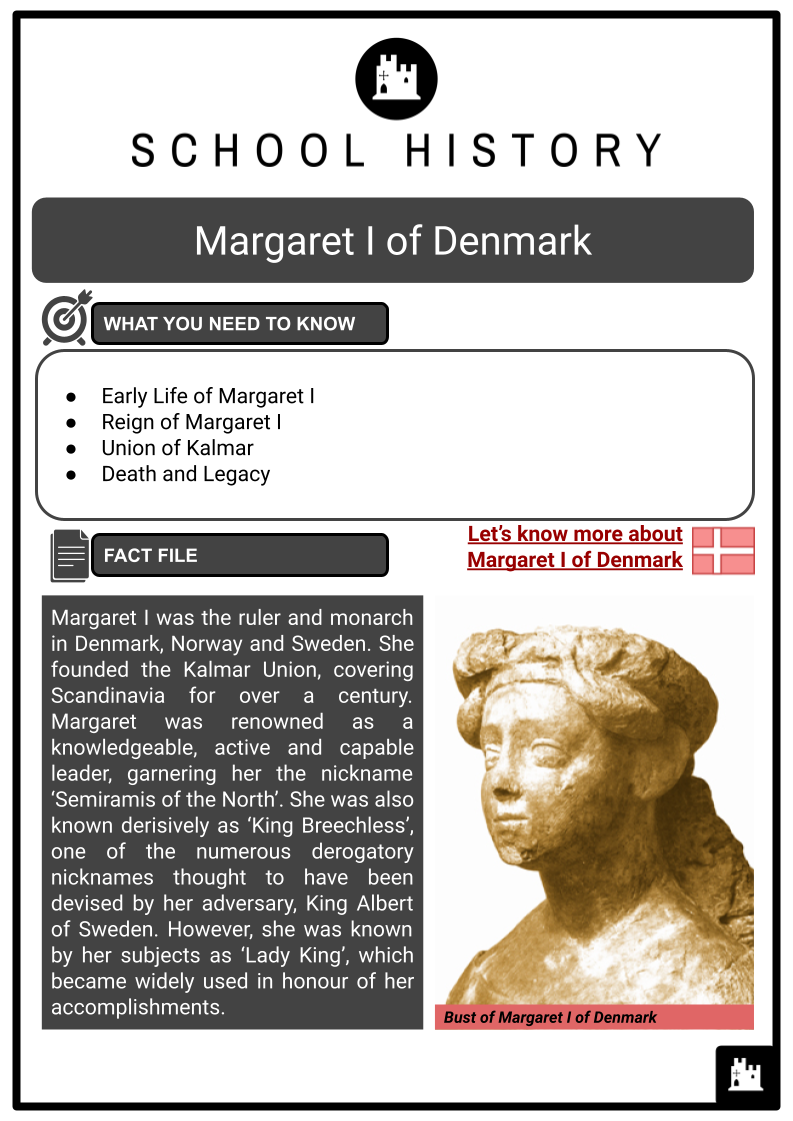
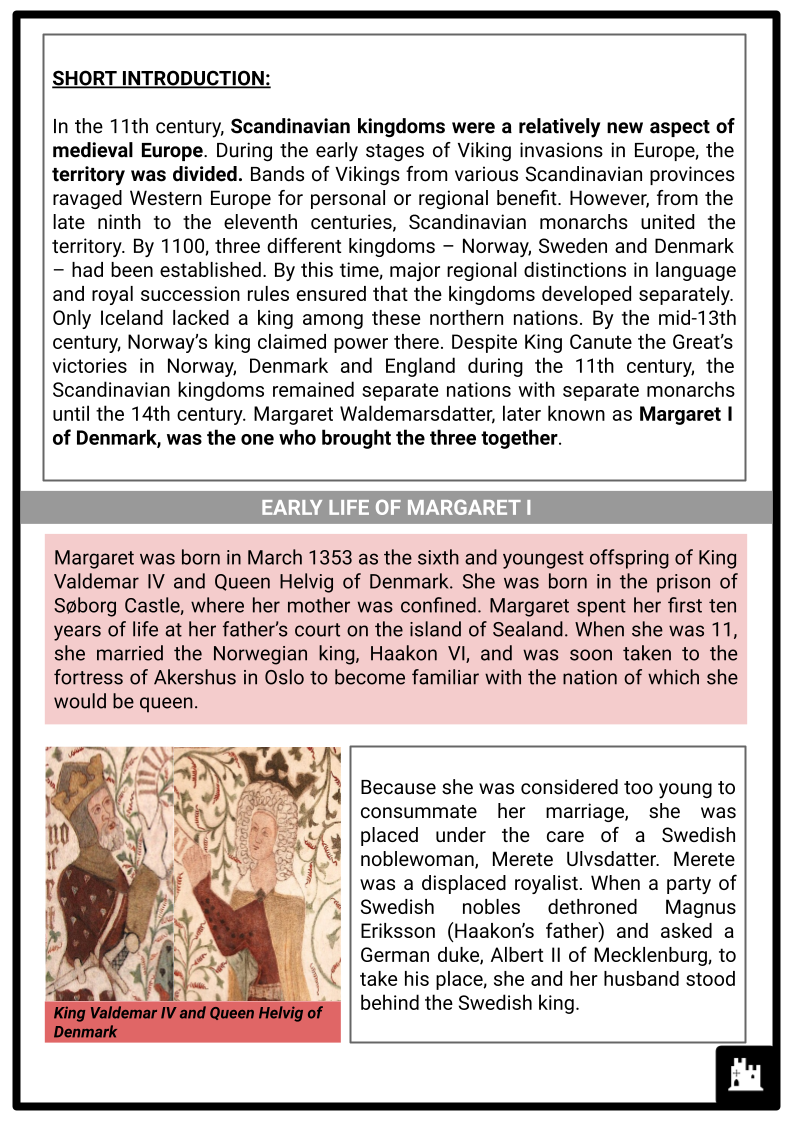
Student Activities
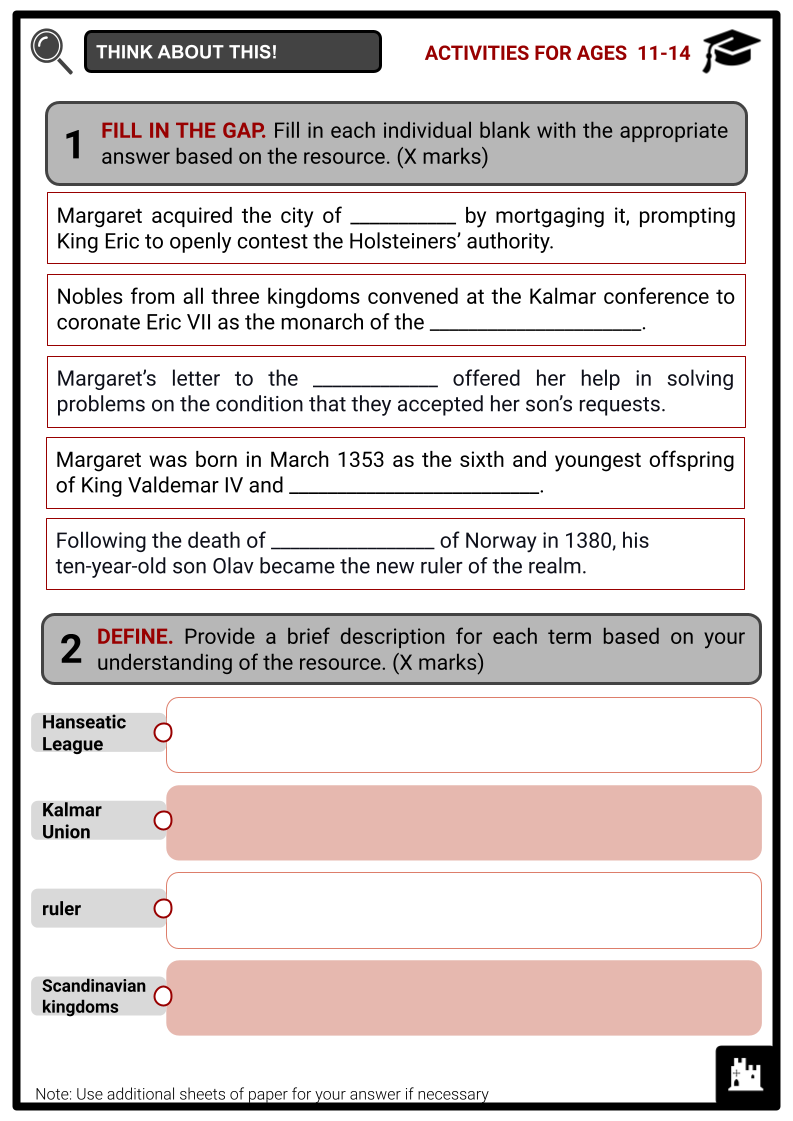
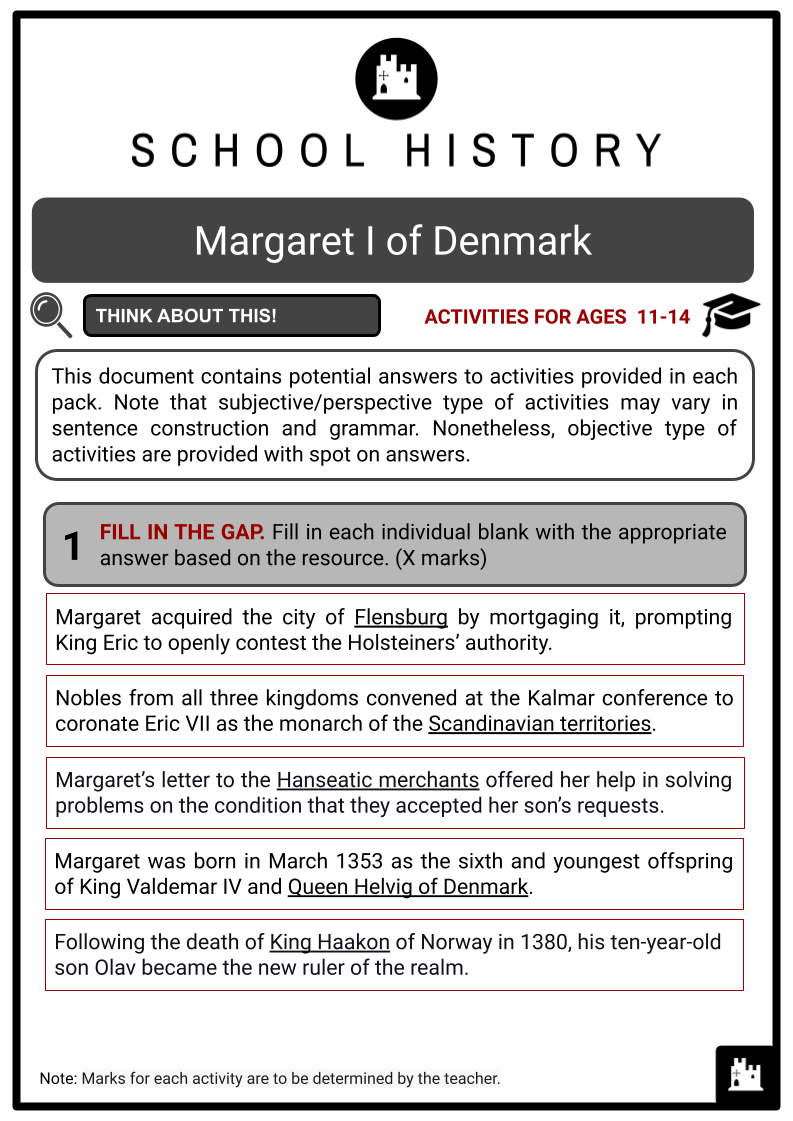
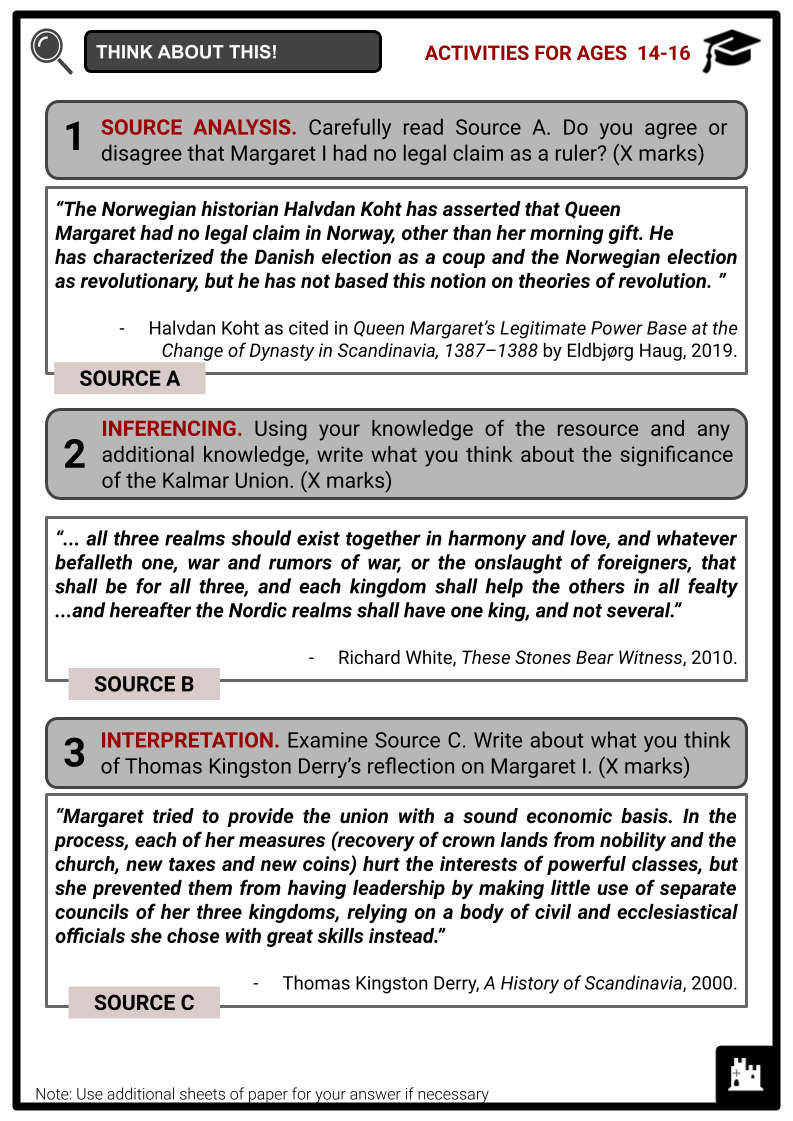
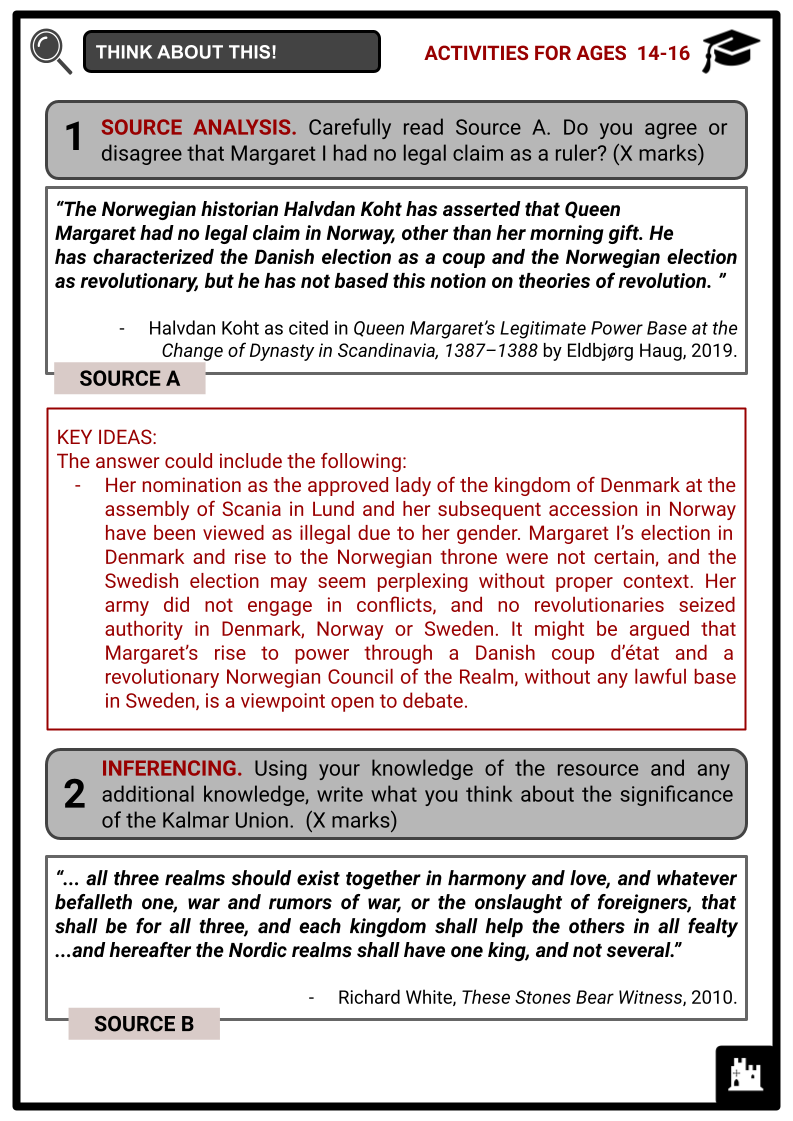
Summary
- Early Life of Margaret I
- Reign of Margaret I
- Union of Kalmar
- Death and Legacy
Key Facts And Information
Let’s know more about Margaret I of Denmark!
Margaret I was the ruler and monarch in Denmark, Norway and Sweden. She founded the Kalmar Union, covering Scandinavia for over a century. Margaret was renowned as a knowledgeable, active and capable leader, garnering her the nickname ‘Semiramis of the North’. She was also known derisively as ‘King Breechless’, one of the numerous derogatory nicknames thought to have been devised by her adversary, King Albert of Sweden. However, she was known by her subjects as ‘Lady King’, which became widely used in honour of her accomplishments.
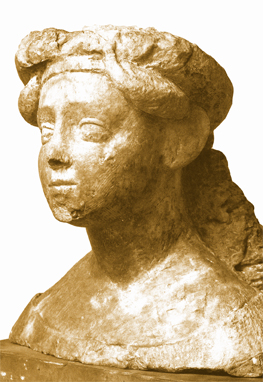
SHORT INTRODUCTION:
In the 11th century, Scandinavian kingdoms were a relatively new aspect of medieval Europe. During the early stages of Viking invasions in Europe, the territory was divided. Bands of Vikings from various Scandinavian provinces ravaged Western Europe for personal or regional benefit. However, from the late ninth to the eleventh centuries, Scandinavian monarchs united the territory. By 1100, three different kingdoms – Norway, Sweden and Denmark – had been established. By this time, major regional distinctions in language and royal succession rules ensured that the kingdoms developed separately. Only Iceland lacked a king among these northern nations. By the mid-13th century, Norway’s king claimed power there.
Despite King Canute the Great’s victories in Norway, Denmark and England during the 11th century, the Scandinavian kingdoms remained separate nations with separate monarchs until the 14th century. Margaret Waldemarsdatter, later known as Margaret I of Denmark, was the one who brought the three together.
EARLY LIFE OF MARGARET I
- Margaret was born in March 1353 as the sixth and youngest offspring of King Valdemar IV and Queen Helvig of Denmark. She was born in the prison of Søborg Castle, where her mother was confined. Margaret spent her first ten years of life at her father’s court on the island of Sealand. When she was 11, she married the Norwegian king, Haakon VI, and was soon taken to the fortress of Akershus in Oslo to become familiar with the nation of which she would be queen.
- Because she was considered too young to consummate her marriage, she was placed under the care of a Swedish noblewoman, Merete Ulvsdatter. Merete was a displaced royalist. When a party of Swedish nobles dethroned Magnus Eriksson (Haakon’s father) and asked a German duke, Albert II of Mecklenburg, to take his place, she and her husband stood behind the Swedish king.
- Margaret’s marriage was therefore a part of the Nordic power dynamic. Some people were dissatisfied with this, and political activist Bridget of Sweden criticised the accord in a letter to the Pope as ‘children playing with dolls’. King Valdemar hoped to reclaim Scania, which had been mortgaged to Sweden since 1332, through marriage.
- While under Merete’s care, Margaret became close to her daughters Ingegerd and Catherine. Ingegerd was the one who taught religion and monarchy to Margaret. In the years following Margaret’s wedding, Scandinavia experienced several important political upheavals. Shortly after her wedding, her sole brother, Christopher, Duke of Lolland, passed away, leaving her father without a clear male successor.
- In 1364, the Swedish nobles ousted Margaret’s husband and father-in-law from the Swedish throne and installed Albert of Mecklenburg as King of Sweden.
REIGN OF MARGARET I
- Margaret was summoned to Denmark in 1375, at the age of 22, after King Waldemar IV died. No successor to the Danish throne had been chosen, even though Waldemar’s son, the acknowledged heir, had died some years before. At the time, the first in line was Albert, the son of Waldemar’s eldest daughter, Ingeborg, who had married Henry, Duke of Mecklenburg.
- As the younger daughter, Margaret had a smaller claim to her son, but she appeared with her son Olav by her side soon after learning of her father’s death and persuaded the state council to crown the five-year-old Olav as king of Denmark and her as the guardian.
- After King Haakon of Norway passed away in 1380, his ten-year-old son Olav inherited the kingdom, and Margaret was appointed as his guardian once more. She and Olav journeyed to Norway, where Olav was officially crowned King in Oslo.
- Margaret was prepared to fight the Hanseatic League’s dominance in Baltic trade and considerable land ownership in the Scandinavian lands, with two crowns on her head.
- The land holdings were acquired through purchases and leases from the succession of profligate monarchs who had succeeded Margaret’s father. She began with the most lucrative, the estates in southwest Sweden (Scania) with their castle fortifications guarding the gateway to the Baltic.
- Her father had been compelled to mortgage them for 15 years, but the deadline for repossession was in 1385. However, the merchants refused to release either property or castles. Hence, Margaret had Olav send a letter expressing his royal fury at being denied his princely claims and threatening serious repercussions.
- Margaret’s letter to the Hanseatic merchants later pledged her assistance in resolving issues provided they agreed to her son’s demands. Simultaneously, pirates launched unprecedented attacks on Hanseatic vessels in the Baltic.
- When the Hanseatic League complained to Margaret, reminding her that it was the Danish king’s responsibility to maintain the sea safe for trade, she agreed but claimed she couldn’t do much without her Scanian strongholds.
- The Hanseatic merchants surrendered their lands after realising they had been outwitted and were unwilling to go to war to protect them. Margaret had gotten her way, and obtained possession and control of both sides of the Sound that joins the North Sea and the Baltic, demanding and receiving the tax from ships entering the inland sea.
- Her great patience and ability to compromise were also valuable assets in realising her aim of establishing a Baltic empire. To be successful, Margaret needed to incorporate Sweden into her Dano-Norwegian sphere of influence.
- Again, time and circumstance were on her side, so she seized the opportunity. She discovered that the same nobility who had become tired of Magnus Eriksson, Olav’s grandfather, and deposed him had grown equally dissatisfied with Albert of Mecklenburg.
- Margaret strategically had her son declared heir of Sweden as the final descendant of the Swedish royal line while regaining control of the Scanian regions. The good outcomes of the announcement reflect the Swedish nobles’ dissatisfaction: they would rather align themselves with the daughter of King Waldemar, their former adversary in the war for Baltic domination, than be dominated by their king.
- Margaret’s position was further solidified by the fortunate event of the death of Bo Jonsson, Sweden’s most prominent and wealthiest landowner. Without any successors, he entrusted his properties to a group of nobles appointed executors of his will. Their task was to further the interests of the Swedish aristocracy and ensure that his holdings and manors did not return to the crown. The Swedes were anxious, however, that Albert of Mecklenburg would claim the country’s wealthiest estate and the power that came with it and that they would be unable to stop him.
- When Olav died unexpectedly in 1387, Margaret saw the opportunity to attain the Swedish crown. She wept as a mother over the death of her child, yet she moved quickly and forcefully. She had the Danish Council of State declare her ‘Mistress of our realm, Master of our House, and Guardian’.
- In Norway, Margaret I was appointed ‘Regent for Life’. In Sweden, she conversed with the discontented nobility, avoiding conflict with Albert of Mecklenburg until all other options were exhausted. In 1389, she faced and destroyed Albert’s soldiers at the Battle of Falkoebing in Southern Sweden. Albert of Mecklenburg was apprehended by the Danes and imprisoned until he was willing to abandon all claims to Sweden, especially the city of Stockholm, where the Germans exercised the most influence.
- Albert’s lands and assets, the possessions he left to German officials and those he had endowed, returned to the crown. Property lost during the war was returned to the nobles, and all castles and fortifications built during Albert’s reign were dismantled. However, Margaret was adamant in her belief that a country could not be successfully governed without a royal king. She therefore adopted her sister’s six-year-old grandson, Bugislav of Pomerania, whom she diplomatically renamed Eric of Pomerania in honour of the Swedish national saint and numerous Scandinavian kings.
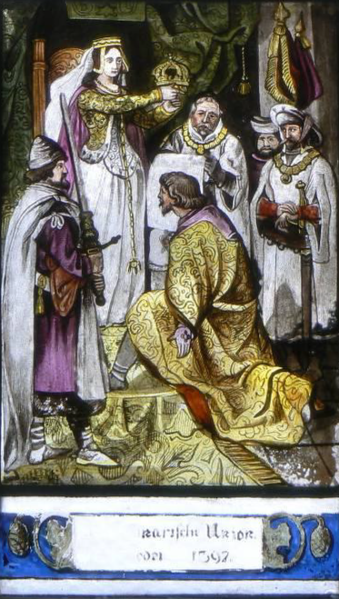
UNION OF KALMAR
- After her father began restoring the Danish kingdom that had been divided and sold off by previous kings, Margaret completed the task by reconstituting Denmark and unifying the three Scandinavian kingdoms.
- The now-famous Kalmar Convention, summoned by Margaret in 1397, honoured and recognised that union. Nobles from all three kingdoms came to the convention to crown Eric VII as King of the Scandinavian lands.
- The coronation document thanks Margaret for her efforts, which resulted in such beautiful rewards. Sixty-seven nobles sealed the document. Only a minority of people signed the charter that formally established the union.
- Despite the magnificent vision of a Nordic union unlike any other before or since, fear of dominant Danish control precluded the required agreement for its existence.
- It existed for 126 years until 1523 when Sweden broke away. The union between Denmark and Norway lasted until 1814 when England broke it up. Denmark and Norway had been together for 434 years at that point.
- The purpose of the Kalmar Union was to secure peace among the three kingdoms. They would collectively choose a monarch, and each nation would acknowledge the sovereignty of the others. They were on equal footing, with no single country allowed to dominate the others. Eric was the king of all three kingdoms, with Margaret as the ruler.
DEATH AND LEGACY
- Widowed duchess Elizabeth of Brunswick allied with Margaret to protect herself from the Holstein dukes who wanted to remove her custody of Schleswig. Elizabeth discovered that Margaret was prepared to assist her by purchasing mortgages or properties in Schleswig, following the successful German technique from previous eras.
- When Margaret obtained the city of Flensburg through a mortgage, King Eric entered and openly challenged the authority of the Holsteiners. They became anxious about the prospect of a division between Holstein and Schleswig, leading to a rebellion in 1409.
- Eric accepted the challenge and prepared for battle against the rebels. Margaret, known for her preference for peaceful solutions, successfully intervened and secured a five-year truce. On 24 October 1412, she arrived at Flensburg to accept the inhabitants’ pledge of loyalty on behalf of Eric.
- That process of reconciliation led to her death. She contracted the plague spreading across the city and passed away on 28 October 1412 aboard her royal ship docked in Flensburg’s harbour. Margaret I was 59 years of age.
- Ten years later, King Eric built a sepulchral monument honouring his renowned foster mother. The lid features a figure made of alabaster depicting a young gothic queen with an intricate hairstyle, a linen headpiece adorned with a crown, a low-cut gown, and bells attached to her waist with chains.
Frequently Asked Questions
- Who was Margaret I of Denmark?
Margaret I of Denmark, also known as Margaret the Great, was a medieval queen who ruled Denmark, Norway, and Sweden during the late 14th and early 15th centuries.
- What were Margaret I's major achievements?
Margaret's major achievements include consolidating the three kingdoms of Denmark, Norway, and Sweden under a single ruler, laying the foundation for the Kalmar Union. She successfully negotiated peace treaties, expanded her territories, and established her dynasty's dominance in Scandinavia.
- How did Margaret I come to power?
Margaret became regent of Denmark in 1375 after the death of her son, King Olaf II, and effectively ruled on behalf of her son's successor, her grandnephew, King Olaf IV. She later seized power and was crowned queen in her own right in 1387 after deposing her grandnephew and assuming control of the kingdom.
